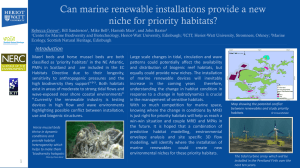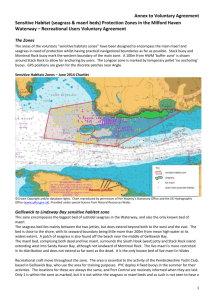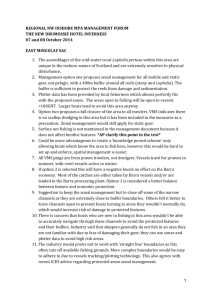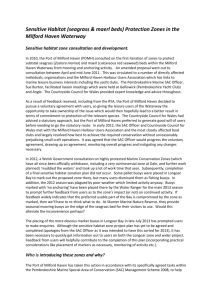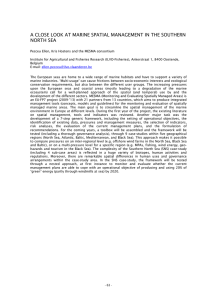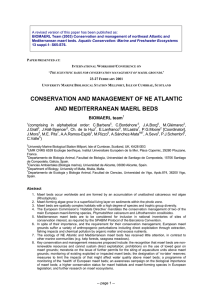ICES ASC September 2000: Theme session on classification and mapping... CM 2000/T: 15
advertisement
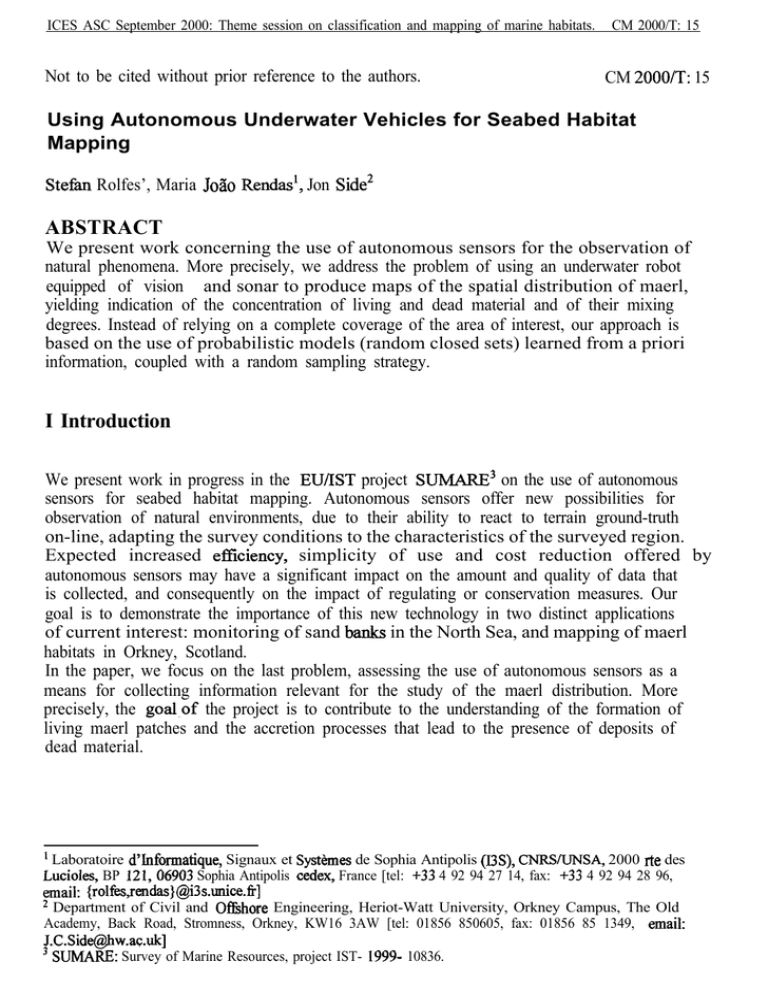
ICES ASC September 2000: Theme session on classification and mapping of marine habitats.
Not to be cited without prior reference to the authors.
CM 2000/T: 15
CM 2000/T: 15
Using Autonomous Underwater Vehicles for Seabed Habitat
Mapping
Stefan Rolfes’, Maria Jo30 Rendas’, Jon Side*
ABSTRACT
We present work concerning the use of autonomous sensors for the observation of
natural phenomena. More precisely, we address the problem of using an underwater robot
equipped of vision and sonar to produce maps of the spatial distribution of maerl,
yielding indication of the concentration of living and dead material and of their mixing
degrees. Instead of relying on a complete coverage of the area of interest, our approach is
based on the use of probabilistic models (random closed sets) learned from a priori
information, coupled with a random sampling strategy.
I Introduction
We present work in progress in the EU/IST project SUMARE on the use of autonomous
sensors for seabed habitat mapping. Autonomous sensors offer new possibilities for
observation of natural environments, due to their ability to react to terrain ground-truth
on-line, adapting the survey conditions to the characteristics of the surveyed region.
Expected increased efficiency, simplicity of use and cost reduction offered by
autonomous sensors may have a significant impact on the amount and quality of data that
is collected, and consequently on the impact of regulating or conservation measures. Our
goal is to demonstrate the importance of this new technology in two distinct applications
of current interest: monitoring of sand banks in the North Sea, and mapping of maerl
habitats in Orkney, Scotland.
In the paper, we focus on the last problem, assessing the use of autonomous sensors as a
means for collecting information relevant for the study of the maerl distribution. More
precisely, the goalof the project is to contribute to the understanding of the formation of
living maerl patches and the accretion processes that lead to the presence of deposits of
dead material.
’ Laboratoire d’htformatique, Signaux et Systemes de Sophia Antipolis (DS), CNRYUNSA, 2000 rte des
Lucioles, BP 121,06903 Sophia Antipolis cedex, France [tel: +33 4 92 94 27 14, fax: +33 4 92 94 28 96,
email: {rolfesJrendas}@i3s.unice.f?]
* Department of Civil and Ofihore Engineering, Heriot-Watt University, Orkney Campus, The Old
Academy, Back Road, Stromness, Orkney, KW16 3AW [tel: 01856 850605, fax: 01856 85 1349, email:
J.C.Side@hw.ac.uk]
3 SUMARE: Survey of Marine Resources, project IST- 1999- 10836.
ICES ASC September 2000: Theme session on classification and mapping of marine habitats. CM 2000/T: 15
Figure 1: The ROV Phantom used in SUMARE
In the project, field surveys will be conducted using an underwater vehicle,4 see Figure 1,
equipped of a wide suite of sensors including a Tritech profiler sonar and a SONY video
camera, with the goal of producing maps of the distribution of areas of living, dead
material and mixtures thereof. A first survey campaign has been done in the first week of
August 2000, where a large number of maerl beds have been detected. For each one, a
large volume of data has been recorded (video and sonar), with the goal of gathering
learning data, for both the recognition algorithms required for automatic vehicle guidance
and for the probabilistic models of maerl occurrence and spatial distribution. Once this
learning step has been completed, another campaign will be conducted, with the vehicle
in autonomous or semi-autonomous mode. Obviously, time and cost limitations preclude
complete coverage of the entire Wyre Sound, i.e., the production of an exhaustive map of
the entire region of interest to the study. Our goal with respect to this application is thus
two-folded:
. Demonstrate the effectiveness of autonomous sensors as a means of intelligent
(selective) observation of environmental phenomena, enabling the surveyor to focus
on areas or features of special inferesf, for instance to track boundaries of regions of
dead or living maerl, or to guide observations along regions of given geophysical
parameters (constant depth, current strength, .)
. Demonstrate their ability to infer (coupled with appropriate models of the phenomena
under study) global characteristicsfrom local observations.
In this communication we concentrate of the last goal: to show that autonomous sensors
can be an effective mean to learn models of the possible spatial distribution patterns of a
given species, and that they can later use these models on-line to recognize a given
situation and extrapolate local information to tier global parameters.
The project’s approach is based on the interplay of four components: modeling,
signal/image processing, control and statistical inference.
Modeling will use the formalism of random closed sets, briefly presented on the next
section, describing the spatial distribution patterns of maerl as a realization of a doubly
stochastic process, whose control parameters statistical distributions will be learned using
’ The ROV Phantom, produced by Deep Ocean Engineering, USA
ICES ASC September 2000: Theme session on classification and mapDing of marine habitats. CM 2000/T: 15
existing a priori knowledge and field data from the first survey campaign. The problem of
model learning is assessed in Section III.
During the actual survey, the vehicle uses vision/sonar to incrementally update estimates
of the control parameters of the stochastic model.
This requires the on-line discrimination of the classes of interest. Preliminary work on
images acquired in Orkney during August suggest that living maerl can be effectively
identified from images taken at a safe distance from the bottom (around 3 meters),
offering a good compromise between coverage efficiency and reliability of
discrimination. The video segmentation algorithm used in these first studies is based on
the.technique of vector quantification, with the codewords being chosen such that the
probability of confusing the two main classes of interest (living and dead maerl) is
minimized [3].
Processed sensor data is used for adaptively guiding the platform, in two major ways.
Firstly, it enables direct observation of important shape characteristics of the habitat (e.g.
following boundaries of a class) : in this case, data is directly used to generate the control
signals applied to the motors of the platform. Moreover, it enables, as discussed in
Section IV, the update of estimates of the control parameters of the random closed set
model.
II Modeling Maerl distribution as Random Closed Sets
Existing knowledge about the habitat of maerl [l] suggests a patchy spatial pattern. The
frequency of occurence (the number of patches counted in an area) and the characteristic
size of the patches are largely determined by the physical characteristics of the
environment: the ocean current, depth and exposure ievel.
A maerl map can thus naturally be represented as a collection of compact sets 5:i (each
one corresponding to a patch), spatially located at sites pi
m
E:=
UC F
-i
+pJ
i-1
In the previous equation, the individual compact sets Zi describe the geometric
properties of the patches, such as shape, size and density, and pi indicates their spatial ’
location. We use the theory of random closed sets (RCS) in order to build statistical
models that describe the global properties of the collection of patches. See [2] for details
on the theory of RCS, which are also called germ-grain models. These models describe
complex spatial patterns by using a doubly stochastic mechanism. A first random point
process p describes the spatial locations (germs) at which, realisations of a second
stochastic process (grains) determine the local morphology of the field, i.e., the
characteristics of the sets Ei .
ICES ASC September 2000: Theme session on classification and mapping of marine habitats. CM 2000/T: 15
The germ model (point process) characteristics define the global dispersion of the field;
which can in particular be clustered, regularly structured or uniformly distributed. We
assume that the distribution of the point process belongs to a parametrized family, by
considering that the associated counting measure ,D is a member of GP:
psGP= hJ E 4,
denoting by il the collection of parameters that determine the statistical distribution of the
locations pi.
The grain model (shape process) constrains the possible elementary shapes, for instance
to circles or lines of random size and orientation. As for the germ model, we consider
also that the distribution of the shape process can be parametrized by a finite number of
parameters, if required using mixture models to describe all possible appearances of the
maerl patches, such that
Once the model type (e.g. the families of distributions GP and GE) and its parameters
B = (2,~) are known, the moments (average, variance) of the overall surface covered by
the patches inside the area of interest can be estimated over any area of interest. In the
project we try to exploit this interesting property to estimate the amount of living and
dead material over extended areas. From local observations we will estimate the process
control parameters 8, and use them to infer global maerl distribution over surrounding
regions. The main advantage of this approach is that we don’t need to map each and
every patch individually. Instead, we just need to gather enough observations to
accurately estimate the global characteristics of the field expressed by the low
dimensional parameter vector 0.
We assume that the process control parameters 8 depend on the physical characteristics
of the environment at each locationp, which we denote by p(p) . This is in agreement, as
we said before, with existing studies that suggest that maerl occurrence can be predicted
using a reduced set of local indicators (depth, current strength and exposure level)
We assume that over conveniently defined neighborhoods, the dependency of 8 on 47 can
be modelled by a function
dependent on a set of parameters a, whose values are drawn from a known distribution
p(a). In this way, we can capture the field variations between areas of similar
geophysical characteristics.
Note that knowing 0, i.e., the RCS model control parameters, is equivalent to knowing
the parameters a. We will call a the structural parameters of the field.
It is a fundamental result on the theory of random closed set models that knowledge of
their underlying distributions (germ%and qain models1 is completely equivalent to the
specification of th&r hitting probabilities. The hitting probabilities specify, for each
ICES ASC September 2000: Theme session on classification and mapping of marine habitats.
CM 2000/T: 15
possible closed set CD the probability of non-empty intersection with the spatial process
=Y.
\
_ T~(~(~)) (CD) = pr~b(~(~)) en m + 01,.
To compute the right-handside of this equation, we must know 6, or, equivalently, the
structural parameters a.. We will explicitely indicate the dependency of the hitting
probabilities on a by writing
The parameter of interest, the amount of maerl in a region A (compact set), Smaerl, can
thus be obtained by integrating the hitting probability over the whole surface
These probabilities can be empirically estimated from a large number of observations of
3, enabling subsequent estimation of the structural parameters cr; which define the spatial
dependency of the RCS model control parameters 0.
The modeling approach describe above considers only first-order characterisation of the
field process, its spatial coherence being imposed by the function go and the structural
parameters a. A more complex statistical modeling approach would consider B to be a
stochastic (spatial) stochastic process, and impose constraints in its-spatial correlation
However, we think that the approach chosen here is well adapted to biological studies,
where an expzanation model of a given phenomenon is sought, as a function of a number
of explanatory variable (here the geophysical parameters 9). Note that if these parameters
are indeed sutkient for predicting the occurrence and appearance of maerl, ‘then the
entropy of the random variable a should be small. On the contrary, a large entropy of this
random variable indicates that e, is not sufEcient, and that other parameters should be
taken into account in the model.
III Model learning
Learning the distribution of maerl requires learning of fij the model type, i.e., the families
of distibutions GP and G,- and of the structural parameter a and (ii) learning of the
corresponding process structural parameters, which determine the intensity ;1 function
describing the spatial distribution of the parameters y of the distribution of the
morphological characteristics of the patches.
We will consider two candidate modeling hypotheses.
ICES ASC September 2000: Theme session on classificationand mauuing of marine habitats. CM 2000/T: 15
-4
Under the first one we assume that individual patches can be distinguished, enabling
separate estimation of the intensity ;Z and of the distribution of the morphological
characteristics.
Namely, we consider that Gp is the general farniliy of non-stationary Poisson processes,
with the intensity parameter being a smooth Cmction”of a@) at each point p. The
description of the shape of each patch will use the theory of shape introduced by
Grenander, which enables to describe a priori shape models by defining a distribution of
graphs that describe the interconnection of elementary shape forms.
Under the second modeling hypothesis we do not assume that clearly identification of
each patch is possible. We describe the point process as a clustered process: each cluster
center (which is itself a Poisson process with intensity parameter I,, is the origin of a
second non-isotropic Poisson process, with intensity described by Zp In this case&e
shape process can be very simple, for instance, circles of random circle (with the radius
being a random variable with known a priori density).
Note that while in the first approach all the complexity ,of shape description is contained
in the shape process, the second translates this responsibility to the definition of the local
intensity of each cluster.
For both modeling approaches, the RCS model control parameters will be, as said
previously, expressed at each point as a Cmction of its geophysical characteristics p.
Learning the field model, when the model type has been fixed, amounts thus to learn the
funcitonal form of go and the statistical distribution of the parameters cx To learn this
distribution, we will use the the observations of an significant part of the Orkney seabed
collected in the August survey campaign. This first model will of course be updated with
new observations acquired during subsequent survey missions.
Using video mosaicing algorithms [3] developped at IST, Lisbon, Portugal (one of the
SUMARE partners) a sequence of images recorded by the camera of the autonomous
vehicle while moving over the ocean bed are ‘glued’ together by associating features of
the partly overlapping regions. We obtain in this way a global image of a large portiqn of
the seabed. Automatic image processing (initially supervised by an expert) performs a
segmentation of the image (using vector quantification method [4]) into areas covered by
dead and living maerl. It is this segmented image, together with knowledge of the
physical characteristics of the observed areas, that will be used to estimate go and p(q).
Alternatively, we can use the ability of the vehicle to track the boundaries between living
and dead material, producing in a more efficient way the global map of maerl patches
inside a given area. This approach could not be used in Orkney, since one of the goals of
this campaign was to acquired learning data for the classification algorithms that will
automatically discriminate them automatically, but it will developped and applied in the
future.
ICES ASC September 2000: Theme session on classification and mapping of marine habitats.
CM 2000/T: 15
Work with simulated images has already validated our approach showing that we can
identify the strctural parameters from partial observations of process realisations. The
work is now in progress using the data acquired at Orkney.
IV Habitat mapping
In the previous section we addressed the problem of learning, probabilistic models for the
statistical distribution of the intensity and shape parameters of random closed set models,
as a function of the physical characteristics of the region observed.
Figure 2: Random sampling.
In this section we consider that such models exist, and discuss how they can be used to
efficiently produce approximate maps of the maerl distribution over extended regions.
We stress that our maps are not of a common type: they do not indicate the detailed
localisation of each individual maerl patch. Instead, they associate, to each point of the
seabed, a value of the structural parameter a (and thus of the RCS model control
parameters 9. We believe that the information they convene is more directly related to
the goals of marine scientists, directly mapping indicators of spatial dispersion and
agregation degree. Moreover, they can be used as a means of verifying explanatory
models, by using entropy of the distribution of a as a means to assess the sufficieny of
the base parameters 9
During actual survey, the vehicle covers an extended area, constantly computing the
compatibility of the observed pattern as a possible realization of the (learned) statistical
model. This comparison uses ancilliary information about the physical characteristics of
the region and the apriori model described in the previous section.
To be able to directly estimate the hitting probabilities of the field, a completely random
sampling strategy should be adopted: the vehicle should randomly wander in the
observed area, randomly determining the next observed window, see Figure 2. Assuming
these probabilities can be estimated, our mapping problem can then be formulated as the
ICES ASC September 2000: Theme session on classification and mapping of marine habitats.
CM 2000/T: 15
one of estimating, Corn the partial observations inside the square sub-regions in that
figure, the structural parameters of the random closed set that would, with largest
probability, yield the (partial) observed pattern.
We estimate a using a Bayesian approach by maximizing. the a posteriori density, or
equivalently:
&= l&lxp(I* , . .-, In /WM@) ,
a
where the observations & are the images obtained at locations pi. The a priori density of
a is given by the learned a priori model. If the images are obtained at random locations in
the region to be surveyed, such that the observations are independent, we obtain an
unbiased estimation of the hitting probability, and thus a good estimate of a. The images
as basic observations can then be replaced by a set binary indicators at a set of random
locations pi inside each square frame, indicating, whether or not maerl was observed at
location pi
hit(Pi)=
1;pj nE#0
o.p nE=O{ 3 i
In this case we obtain an estimation of the process control parameter by
The actual random generation of the next visited (observed) region, implying a chaotic
motion of the vehicle between points is certainly not the most efficient strategy for
sampling a given region. Alternatively, we can base the computation of the hitting
probabilities on rectangular areas, effectively using the ability of the vehicle to
continuously observe an extended area.
We stress that the sample trajectory (e.g. a set of connected straight lines) (see figure 3)
must.. be chosen at random, in order to avoid observation of ‘favorite’ regions. It is
important that the observations do not be concentrated on areas where maerl is expected.
Negative information is as important for the estimation of the process complete model as
positive information.
In order to avoid violation of the independence assumption of the ,observations we need
to choose locations pi (the locations at which the hitting probabilities are estimated) at
random along this sampling path, rather than using the whole area that is observed by the
vehicle.
ICES ASC September 2000: Theme session on classification and mauuina of marine habitats. CM 2000/T 15
Figure 3: sampling using straight lines.
V Conclusions
We presented in this paper work in progress in the European project SUMARE,
concerning the use of autonomous sensors for study of the distribution of underwater
ressources, focusing on one of the applications considered in the project: mapping of
maerl in Orkney. We discussed the advantages that provide an autonomous sensor,
allowing periodical mapping of natural phenomena, such that evolution of the phenomena
can be observed permanently. An important advantage of autonomous sensors is
augmented efficiency (observations can be done permanently), while costs are reduced.
We propose an approach that uses the theory of random closed sets, in order to model the
distribution of maerl. The process control parameter will be estimated based on learned a
priori information (obtained from large images of the seabed, taken in August). This a
priori information will be updated throughout following observation campaigns during
that the vehicle acquires images along a random sample path, covering a large portion of
the field. Habitat mapping done by an autonomous sensor has the additional advantage,
that the information gathered along this sampling path contains negative as well as
positive information obtained at random locations, while human observers tend to map
mainly areas where maerl is found, such that the estimated distribution of the maerl is just
reliable in these observed areas.
Acknowledgments
This work has been partially funded by the European Union through research contract
IST-1999-10836 (SUMARE: Survey of Marine Resources).
References
[l]
Nicola White , ‘The distribution of maeri in Orkney’ Master Thesis, Department of Civil and
’ Offshore Engineering Heriot-Watt University, Orkney; 1999
[2] Bardorff-Nielsen, O.E.; Kendall, W.S.; van Lieshout, M.N.M.; ‘Stochastic Geometry,
Likeleehood and Computation’; Chapman & Hail/CRC; 1999
[3] Nuno Gracias, ‘Application of robust estimation to computer vision: Video mosaicing and 3-D
reconstruction’ Master Thesis at ‘Universidade Tecnica de Lisboa’, 1997
ICES ASC September 2000: Theme session on cl&i&&on and maoDing of marine habitats. CM 2000/T: 15
1’
[4] K. 0. Perlmutter et al, Bayes Risk Weighted Vector Quantization with Posterior Estimation for
Image Compression and Classification, IEEE Transactions on Image Pmcessing, Vol 5, No 2,
Freb 19%.
